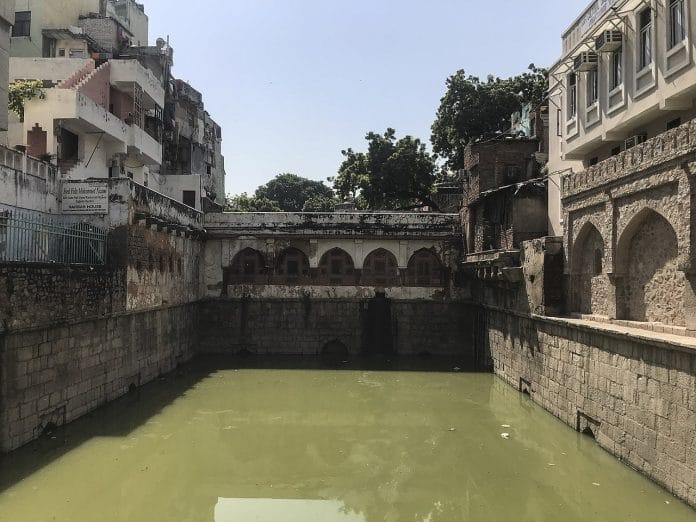A massive photograph captures the decrepit state of a 14th-century baoli near Nizamuddin dargah—its collapsed wall, mounds of floating garbage and stagnant water. That was in 2008. In another photo, the same step well is now whole again; the swirls of water lapping gently along the walls. Pictorial records of the over decade-long restoration effort by the Aga Khan Trust for Culture, the Archaeological Survey of India and Delhi’s municipal corporation are now part of a 10-day exhibition at the India International Centre.
Called ‘Restoring Stepwells, Reviving Life’, the exhibition, which opened on 22 July and closes today, shows how eight step wells – two in the Nizamuddin area and six in Qutb Shahi Heritage Park, Golconda, Hyderabad were painstakingly resuscitated.

“We’re here to establish model projects and to disseminate through exhibitions and publications the learnings we’ve done so that these can be replicated across the country,” said Ratish Nanda, CEO of Aga Khan Trust for Culture, at the exhibit. They serve as case studies and can inform other architectural projects and teaching modules.
At the inauguration, Debashree Mukherjee, special secretary, Jal Shakti ministry, described it as a lighthouse project for water management, conservation and raising awareness about water and heritage.
Restoring Nizamuddin baoli
The Nizamuddin baoli, which was built during the time of Sufi saint Hazrat Nizamuddin Auliya, is the only stepwell in Delhi that still has underground springs. It was taken up for revival as part of the Nizamuddin Urban Renewal Project in 2007.
The restoration of the baoli was not done in isolation. According to Nanda, it took two-three months for the team to connect with residents and convince them about the project and its importance. Authorities stepped in to help with relocation efforts.
Also read: A Tamil Nadu engineer restored 142 lakes in India, won’t stop now. Next station is Kenya
Residents whose houses overlooked the stepwell considered it sacred. Its cultural significance and what it meant to pilgrims and residents could not be discounted. When the eastern wall collapsed in 2008, it posed a safety hazard to as many as 18 families occupying the southern terrace and around 5,000 pilgrims who used the corridor daily to visit the dargah.
After many rounds of talks with the dargah committee and the local community, work began on the collapsed portions, along with efforts to clean the step well of debris and 700 years of accumulated dust. Over 40 ft of sludge had to be de-silted. “The manual lifting of sludge required over 8,000 man-days of work,” stated the initiative’s website.
The exhibition also displayed photographs of the Arab Serai, the 16th-century gateway within the Humayun’s Tomb complex that had fallen into disrepair. Large portions of the gateway were close to collapsing.
In 2021, the conservation project of the Nizamuddin area, which includes Humayun’s Tomb, the Nizamuddin basti and Sunder Nursery, among other Mughal-era sites, won two UNESCO awards in 2021.
Challenges to restoring Badi Baoli
The Aga Khan Trust for Culture and the Telangana government joined hands with Tata Trusts to take on restoration work at the 106-acre Qutb Shahi Complex near Golconda Fort in 2012. Here, the team discovered six stepwells that served as water-collecting chambers.
The trust used traditional Indian techniques for conservation, carried out over eight years. In contrast to the Nizamuddin baoli, these did not hold any sacred significance and served to irrigate the adjacent garden enclosures.
Also read: An old Delhi heritage walk that’s not about Jama Masjid, Red Fort. It tells queer histories.
Some of these 16th-century step wells were filled with earth over time, while others crumbled. Take the Badi Baoli, for example. As soon as conservation work commenced in 2013, its western façade collapsed due to heavy rains, delaying restoration efforts by several months.
This wouldn’t be the only hurdle in their way. According to a Tata Trusts article on the restoration work, another major challenge was removing 450 cubic meters of stone debris and silt from the Badi Baoli complex. It was lifted manually from a depth of about 21 metres and took 4,000 days to complete. Six hundred cubic metres of stone masonry was reconstructed within three years with traditional building tools and techniques.
Today, the step well collects over 33 lakh litres of rainwater, which is used to continue conservation work and helps save annual water carriage costs to the site.
From the deserts of Rajasthan to the gardens of Hyderabad, step wells built to collect runoffs and rainwater centuries ago may offer solutions to a world battered by depleting groundwater levels and climate change-induced drought. The Nizamuddin baoli is said to have healing properties, but the magic lies in its restoration.
(Edited by Zoya Bhatti)






